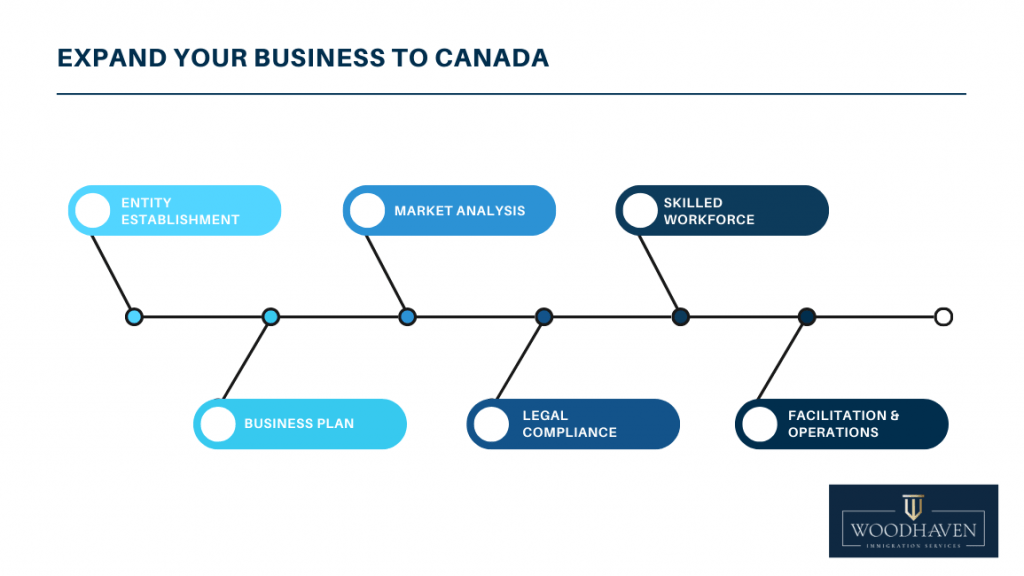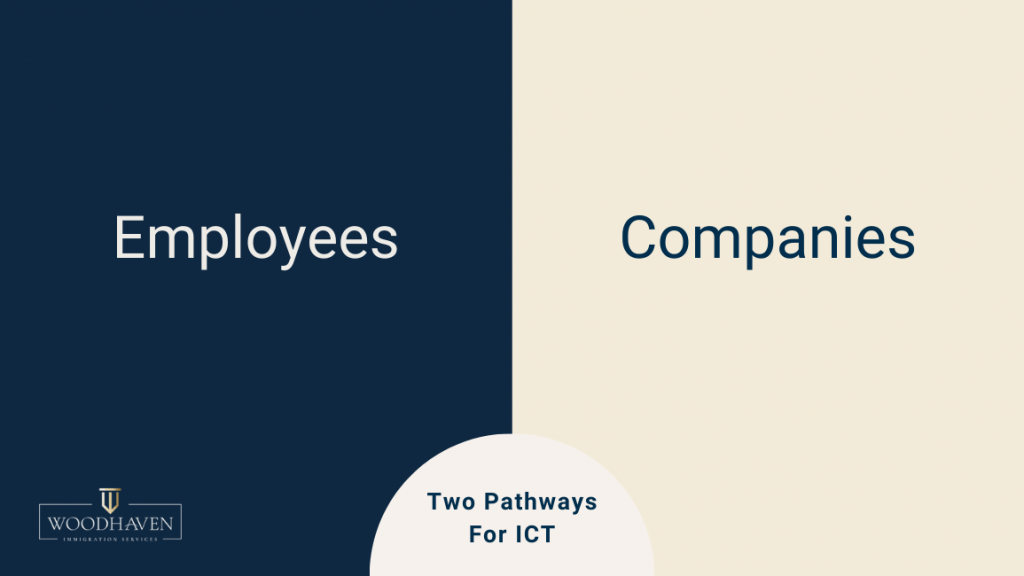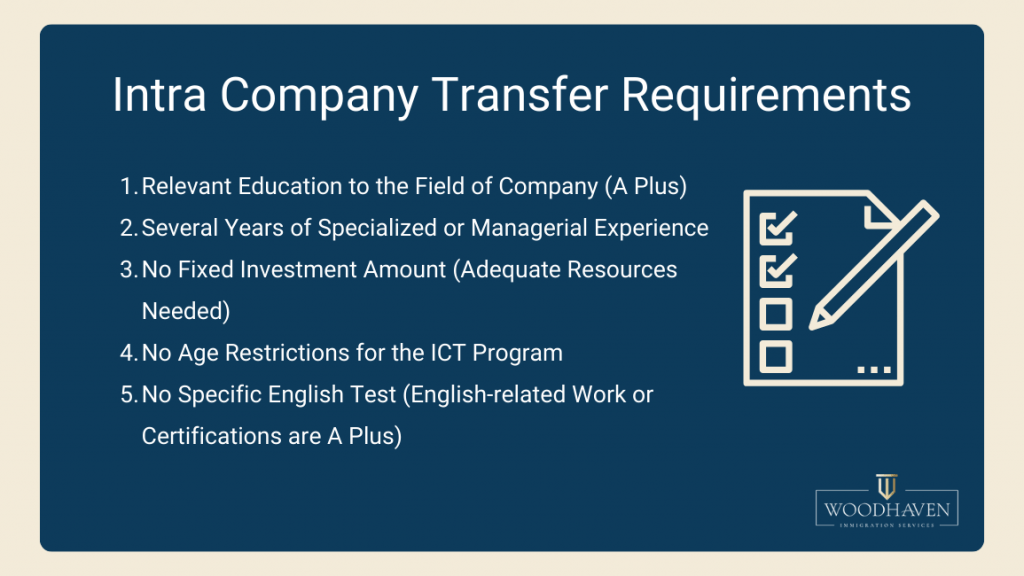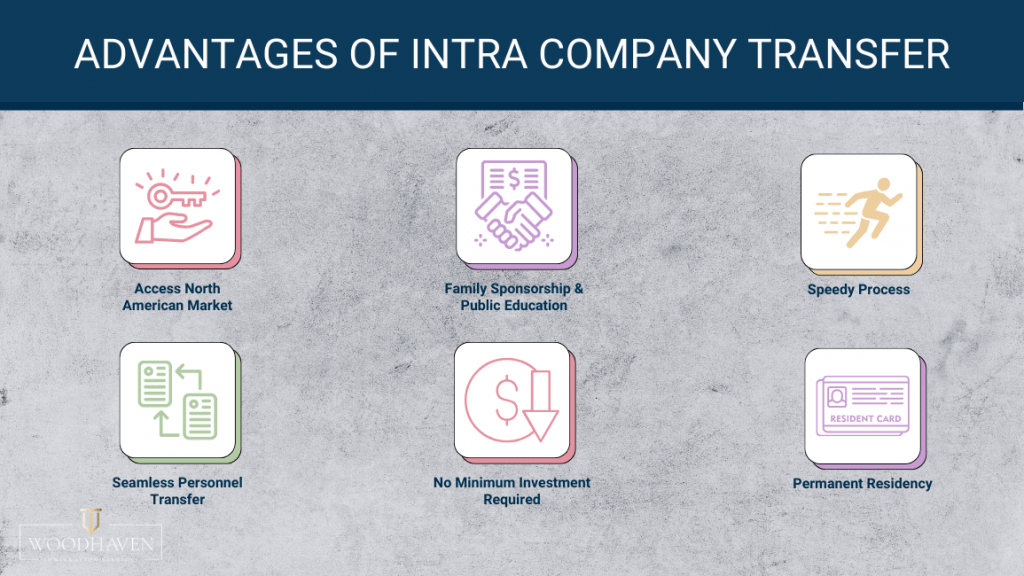Canada’s Intra Company Transfer Program: A Comprehensive Guide

Intra Company Transfer Program offers a key pathway to expanding your business to Canada with a multitude of opportunities for growth, access to new markets, and tapping into a highly skilled workforce.
The Intra Company Transfer program stands out as a streamlined option for transferring key personnel or establishing your business in Canada.
In this detailed guide, we explore everything you need to know about the ICT program in Canada, from its fundamentals to its particulars and benefits.
How to Expand Your Business to Canada?
Expanding your business to Canada requires careful planning, market analysis, and compliance with immigration regulations.
With its stable economy, robust infrastructure, and skilled workforce, Canada offers an attractive destination for businesses seeking international expansion.

What is Intra Company Transfer?
Intra Company Transfer program means two distinctive routes of immigration. One denotes that multinational companies relocate key personnel, encompassing executives, managers, and other knowledge workers, to their Canadian subsidiaries or affiliates.
The second route entails establishing your foreign company in Canada as the Intra Company Transfer program offers a smooth transfer of your company with a robust plan and operations. But what route is best for you? You need to examine the requirements carefully first.

Who Can Apply for the Intra Company Transfer Program?
Perfect candidates for the Intra Company Transfer program include employees who have been employed by the sponsoring company with the qualifying:
- Minimum Period with specialized knowledge
- Managerial Experience
- Executive-level Responsibilities
Eligibility criteria may vary depending on the specific requirements of the program.
Intra Company Transfer Requirements
To qualify for the Intra Company Transfer program, applicants must meet specific requirements set forth by Immigration, Refugees, and Citizenship Canada (IRCC).
These requirements typically include:
- proof of employment with the sponsoring company;
- a detailed job description;
- evidence of the applicant’s qualifications;
- evidence of the applicant’s experience.

Investment Amount for the Expansion of Your Business Canada
While the Intra Company Transfer program does not impose specific investment requirements, companies must demonstrate a genuine intention to establish or expand their business operations in Canada.
This may involve investments in infrastructure, hiring local talent, and establishing a physical presence in the country.
Advantages of Intra Company Transfer Program
The ICT program offers numerous advantages for both employers and employees.
For employers, it facilitates the seamless transfer of key personnel to Canadian operations, ensuring continuity and efficiency.
For employees, it offers professional development opportunities, exposure to new markets, and potential pathways to permanent residency.

How to Apply for Intra Company Transfer Work Permit?
The application process for an Intra-Company Transfer work permit involves several steps, including preparing documentation, submitting the application, and attending a visa interview if required. Employers and employees must adhere to specific requirements outlined by IRCC.
Canada Intra Company Transfer Processing Time
The processing time for an Intra Company Transfer visa varies depending on factors such as the volume of applications, the complexity of the case, and the efficiency of processing centers. Applicants should allow sufficient time for application processing and plan accordingly.
Intra Company Transfer Work Permit Duration
The duration of an Intra Company Transfer work permit is typically linked to the duration of the employment assignment in Canada. Once approved, employees may work for the specified period outlined in the work permit, after which they may be eligible for renewal or extension, subject to program requirements.
Canada ICT to PR Transition
While the ICT program itself does not lead directly to permanent residency in Canada, it may serve as a pathway for employees to transition to permanent residency through other immigration programs, such as the Express Entry system or Provincial Nominee Programs (PNPs).
Permanent Residency: The Benefits and How to Get It
Permanent residency in Canada offers numerous benefits, including access to healthcare, education, and social services, as well as the opportunity to live and work anywhere in the country. Individuals may apply for permanent residency through various immigration programs, including Express Entry, Provincial Nominee Programs, and family sponsorship.
Who Can Get an Intra Company Transfer Work Permit for Canada?
Qualified candidates for an ICT work permit include employees of multinational companies who meet specific eligibility criteria, including employment history, job duties, and relationship with the Canadian branch. Applicants must demonstrate that they possess:

ICT Work Permits for Start-Up Companies: What You Need to Know
Start-up companies seeking to utilize the ICT program must meet the same eligibility criteria as established multinational corporations. However, they may face additional scrutiny regarding their business plans, financial stability, and growth potential. Start-up companies need to demonstrate a clear business strategy and the ability to support the transfer of key personnel to Canada.
In conclusion, the Intra Company Transfer program in Canada offers a valuable pathway for multinational companies to transfer key personnel and support the growth of their Canadian operations. By understanding the program’s requirements, benefits, and application process, businesses can navigate the complexities of international expansion with confidence and success.
Immigrating to Canada under the Intra-Company Transfer (ICT) program requires careful consideration of several factors. While specific requirements may vary depending on the nature of your business and your role within the company, here are the general guidelines and minimum requirements for eligibility:

1. Establishing Your Business Presence in Canada
Before applying for the ICT program, your company must have an existing business presence in Canada. This can include a subsidiary, branch office, or affiliate that is actively engaged in commercial activities.
2. Employment with the Foreign Company
As the owner of your business back home, you must have a qualifying relationship with the foreign company that intends to transfer you to Canada. This may include being a senior executive, manager, or employee with specialized knowledge.
3. Minimum Requirements for Applicants
Education
While there are no specific educational requirements for the ICT program, possessing relevant qualifications or professional certifications related to your field of expertise can strengthen your application.
Experience
You should have substantial experience in your industry or field, demonstrating your ability to contribute significantly to the Canadian operations of your company. Generally, several years of managerial or specialized experience are preferred.
Investment Amount
While there is no fixed investment amount required for the ICT program, your company should have sufficient financial resources to support your transfer and establish or expand its presence in Canada.
Age
There are no age restrictions for the ICT program. Applicants of all ages may qualify as long as they meet the program’s other requirements.
English Language Proficiency:
Proficiency in English is essential for effective communication in the Canadian workplace. While there are no specific language test requirements for the ICT program, demonstrating English language proficiency through previous work experience or language certifications can be advantageous.
4. Other Essential Requirements
Job Duties:
Your role within the company should align with the job categories specified by the ICT program, such as managerial positions, executive roles, or positions requiring specialized knowledge.
Genuine Transfer
Your transfer to Canada must be genuine and necessary for the company’s operations. This means that your skills, expertise, or leadership are essential for the success of the Canadian branch or subsidiary.
Compliance with Canadian Laws
Both you and your company must comply with Canadian immigration laws and regulations throughout the application process and your stay in Canada.

Application Process
- Preparation: Gather all necessary documentation, including proof of employment, job description, educational credentials, and any other relevant information.
- Submission: Submit your application for the ICT program through the appropriate channels, providing accurate and complete information.
- Processing: Your application will be reviewed by immigration authorities, who will assess your eligibility based on the program’s requirements.
- Approval: If your application is approved, you will receive an ICT work permit, allowing you to work in Canada for the specified duration.
Applying for permanent residency (PR) in Canada under the Intra-Company Transfer (ICT) program involves navigating the immigration pathways available to individuals who have been transferred to Canada by their employer.
While the ICT program itself does not directly lead to PR status, it can serve as a stepping stone for eligible individuals to pursue permanent residency through other immigration streams. Here’s a guide on how to apply for PR in Canada under the ICT program:
1. Understand Your Eligibility:
Before applying for PR, it’s essential to understand your eligibility and explore the immigration pathways available to you. While the ICT program facilitates temporary work permits for skilled workers, managers, and executives, it does not offer a direct route to PR status. However, individuals under the ICT program may be eligible to apply for PR through other immigration programs.

2. Explore Permanent Residency Pathways:
There are several immigration programs and streams through which individuals can apply for PR in Canada. Some of the common pathways include:
- Express Entry System: The Express Entry system manages applications for three federal economic immigration programs: the Federal Skilled Worker Program, the Federal Skilled Trades Program, and the Canadian Experience Class. Individuals with skilled work experience, language proficiency, and education may be eligible to apply through Express Entry.
- Provincial Nominee Programs (PNPs): Canadian provinces and territories operate PNPs, which allow them to nominate individuals for PR based on their skills, work experience, and ties to the province. Some provinces offer specific streams or pathways for individuals already working in Canada under the ICT program.
- Canadian Experience Class (CEC): The CEC is designed for individuals with skilled work experience gained in Canada. If you have worked in Canada under the ICT program and meet the eligibility criteria for the CEC, you may be able to apply for PR through this stream.
3. Meet the Requirements:
Each PR pathway has its own set of requirements, including work experience, language proficiency, education, and other factors. It’s important to review the specific criteria for the program or stream through which you plan to apply and ensure that you meet all eligibility requirements.
4. Submit Your PR Application:
Once you have identified the most suitable PR pathway and confirmed your eligibility, you can proceed with the PR application process. This typically involves submitting an application to Immigration, Refugees, and Citizenship Canada (IRCC) and providing supporting documentation to demonstrate your eligibility.
5. Wait for Processing:
After submitting your PR application, you will need to wait for IRCC to process your application. Processing times may vary depending on the volume of applications and other factors. You can check the status of your application online through the IRCC website.
6. Complete Additional Steps (if required):
Depending on the PR pathway you choose, you may need to complete additional steps, such as attending interviews, providing biometrics, or undergoing medical examinations. Be sure to follow any instructions provided by IRCC and respond promptly to any requests for additional information.
Final Verdict
While the Intra Company Transfer program itself does not lead directly to PR status, individuals transferred to Canada under this program may be eligible to apply for permanent residency through other immigration pathways. By understanding the requirements and exploring suitable PR streams, you can take steps toward securing permanent residency in Canada. Consider consulting with an immigration lawyer or professional immigration consultant for personalized guidance and assistance with your PR application.
Immigrating to Canada under the Intra Company Transfer program offers a pathway for business owners like yourself to expand their operations and contribute to Canada’s economy. By meeting the minimum requirements and following the application process diligently, you can position yourself for a successful transfer and business venture in Canada. Consider consulting with an immigration lawyer or professional to ensure that your application meets all necessary criteria and requirements.





